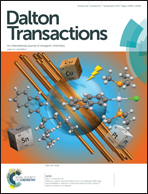Four-coordinate nickel(ii) and copper(ii) complex based ONO tridentate Schiff base ligands: synthesis, molecular structure, electrochemical, linear and nonlinear properties, and computational study†‡
Abstract
We report the synthesis, characterization, crystal structures, nonlinear-optical (NLO) properties, and density functional theory (DFT) calculations of nickel(II) and copper(II) complex based ONO tridentate Schiff base ligands: two mononuclear compounds, [Ni(An-ONO)(NC5H5)] (5) and [Cu(An-ONO)(4-NC5H4C(CH3)3)] (6), and two heterobimetallic species, [M(Fc-ONO)(NC5H5)] (M = Ni, 7; Cu, 8), where An-ONOH2 (3) and Fc-ONOH2 (4) are the 1 : 1 condensation products of 2-aminophenol and p-anisoylacetone and ferrocenoylacetone, respectively. These compounds were characterised by microanalysis, FT-IR and X-ray crystallography in the solid state and in solution by UV-vis and 1H and 13C NMR spectroscopy. The crystal structures of 3–5, 7 and 8 have been determined and show for Schiff base complexes 5, 7 and 8 a four-coordinated square-planar environment for nickel and copper ions. The electrochemical behavior of all derivatives 3–8 was investigated by cyclic voltammetry in dichloromethane, and discussed on the basis of DFT-computed electronic structures of the neutral and oxidized forms of the compounds. The second-order NLO responses of 3–8 have been determined by harmonic light scattering measurements using a 10−2 M solution of dichloromethane and working with a 1.91 μm incident wavelength, giving rather high β1.91 values of 350 and 290 × 10−30 esu for the mononuclear species 5 and 6, respectively. The assignment and the nature of the electronic transitions observed in the UV-vis spectra were analyzed using time-dependent (TD) DFT calculations. They are dominated by LMCT, MLCT and π–π* transitions.


 Please wait while we load your content...
Please wait while we load your content...